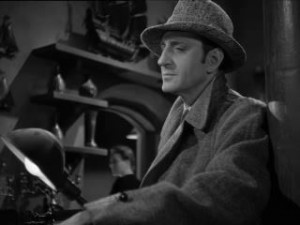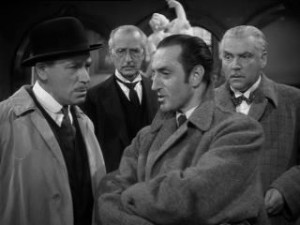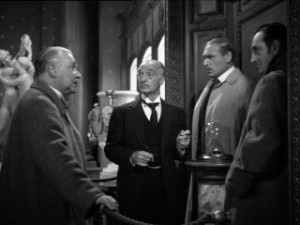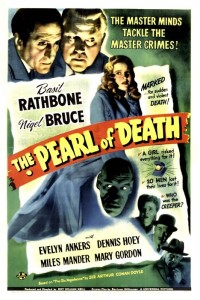Marked… for sudden and violent Death! A Girl risked everything for it! 20 men lost their lives for it! Who was the Creeper?
Universal’s Sherlock Holmes series were made at a breakneck pace but maintained a relatively high level of quality for almost the entire length of the series, faltering only in the finale, 1946’s Dressed to Kill. Although most rank The Pearl of Death towards the weaker end of the series, for my take it is one of the better entries in the series.
Based insanely loosely on the original Arthur Conan Doyle story The Six Napoleons, The Pearl of Death has much to support it, but unfortunately a similarity to its literary predecessor isn’t among them. Outside of the pearl itself and the presence of the six busts of Napoleon there is little from the story visible in the finished film.
What makes The Pearl of Death a stronger entry is that, although still made during the war years, it reverts to a more traditional mystery format than its immediate predecessors, which leaned heavily on the war and took on an increasingly anti-Nazi spy thriller sort of motif. Pearl also has perhaps the most dramatic horror elements for any of the series as well.
Also endearing in the film is the very human portrayal of Holmes by the always spot on [intlink id=”128″ type=”category”]Basil Rathbone[/intlink]. Here it is his almost Watsonesque stupidity which results in the theft of the pearl to begin with. Holmes seeks to demonstrate the inadequate nature of the alarm system for the pearl by rather summarily disconnecting it, only to have the pearl stolen immediately after.
 With its as expected very short run time, there isn’t for much in the way of normal character development, as the plot races from one climax to another. The elements of horror which are added, namely in the sense of the Creeper, the villian’s accomplice who is on the hunt for the pearl and kills his victims by literally breaking their backs, seem rather gratuitous and unneeded. In retrospect it would appear that The creeper is only there to highlight the real life physical deformities of Rondo Hatton, the actor who would play the Creeper in Pearl of Death and two later films.
With its as expected very short run time, there isn’t for much in the way of normal character development, as the plot races from one climax to another. The elements of horror which are added, namely in the sense of the Creeper, the villian’s accomplice who is on the hunt for the pearl and kills his victims by literally breaking their backs, seem rather gratuitous and unneeded. In retrospect it would appear that The creeper is only there to highlight the real life physical deformities of Rondo Hatton, the actor who would play the Creeper in Pearl of Death and two later films.
The conclusion of the film is also somewhat more disjointed than one has come to expect form the series, though here Rathbone’s performance saves the day. His ending dialogue is well presented and perhaps comes in one of the few instances where Rathbone’s Holmes actually seems to display any fear. It is also the one area where there enters into the film a slight propaganda feel. So even though the spy storyline was dropped, there is still the element of wartime furor incorporated as well.
 We also are presented with Nigel Bruce’s Doctor Watson and Dennis Hoey’s Inspector Lestrade, both of whom (especially Watson) appear more buffoonish than usual in this one. However, this is a nice contract to the at least perceived increased humanity of Rathbone’s Holmes.
We also are presented with Nigel Bruce’s Doctor Watson and Dennis Hoey’s Inspector Lestrade, both of whom (especially Watson) appear more buffoonish than usual in this one. However, this is a nice contract to the at least perceived increased humanity of Rathbone’s Holmes.
The Universal entries in the Basil Rathbone / Nigel Bruce Holmes’ series have long been in the public domain and frequently appear on television, especially early morning PBS showing or the $1 bins at Wal-Mart. As with all the Universal entries, take the extra time to seek out the recent UCLA restorations of these films, which are all markedly superior to the existing public domain versions.
 The Pearl of Death though, is still among the weaker looking of the series, but only because the original print has been lost, and the restoration was done on the best print available, which was some generations removed from the original theatrical release. That being said, the restored edition is still the best the film has looked since release in 1944.
The Pearl of Death though, is still among the weaker looking of the series, but only because the original print has been lost, and the restoration was done on the best print available, which was some generations removed from the original theatrical release. That being said, the restored edition is still the best the film has looked since release in 1944.
As with all the films in the series, The Pearl of Death is highly recommended both for the overall quality of the cast and the tightness of the runtime, even if in this case you have some unneeded characters.
